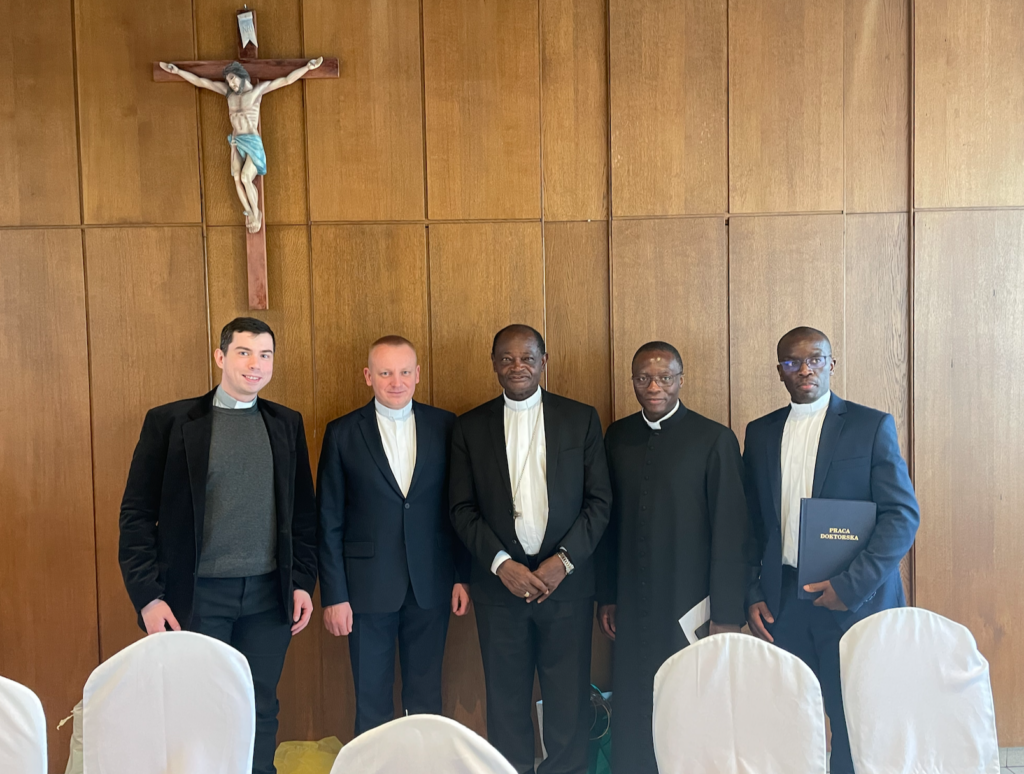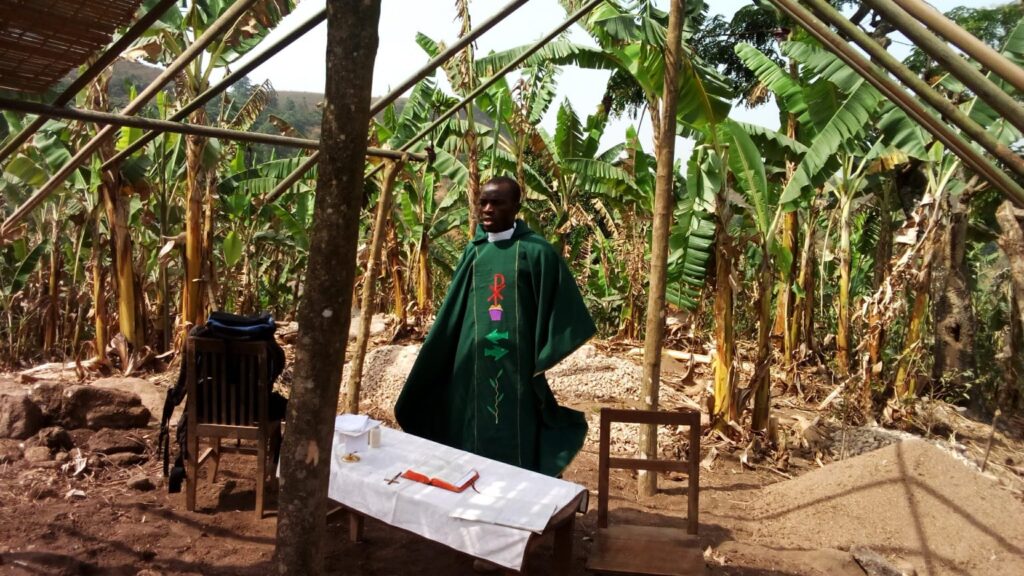THE ANTHROPOLOGICAL BASIS OF THE SPIRITUALITY OF MOTHER TERESA OF CALCUTTA (1910-1997)
Father Marcel Kpudzeka completed his doctoral studies at the Cardinal Stefan Wyszyński University on February 23, 2023. He was also involved in the activities of the Institute of Schuman Thought. He took part in the Christmas Eve Without Borders and Prayer Without Borders – the holy mass celebrated on the 13th of each month for the return to Christian Europe and the beatification of the Servant of God Robert Schuman. Father Marcel also took part in the Chaplet of Divine Mercy prayer. The Institute of Schuman Thought expresses its appreciation and congratulations to you and wishes you God’s blessing in your pastoral ministry among the inhabitants of the African land.
The Institute of Schuman Thought undertook to support the construction of a deep well in Cameroon in the parish of Father Marcel, and we ask that all those willing to join in this help.

INTRODUCTION
Any edifice of human behaviour or activity is built on anthropology: the question of human nature. In fact, phenomena which baffle sane imagination such as slavery and slave trade in their past and present forms, racism, apartheid, the holocaust and genocide are each based on a certain understanding of the human being. Anthropology is likewise factored into the discussion of recent issues like ecology, the situation of immigrants, transgenderism and transhumanism. The ancient question of what the human being is remains ever relevant. Nevertheless, human history abounds not only with tales of woe and savagery, but also of heroism, altruism and philanthropy. Mother Teresa of Calcutta is one of the people who chose the heroic path of altruism and brought relief and comfort to millions of poor people. Her compassion for the weakest and most vulnerable members of the society is what inspired this study. It is believed that the world will come well-nigh to solving all the humanitarian crises it is facing if everyone learns to see human beings from Mother Teresa’s perspective. Ever since her humanitarian efforts attracted the attention of the press, Mother Teresa has remained in the limelight.
LITERATURE REVIEW
The quest to know better the figure, work and legacy of this religious personality has continued to generate volumes of written works. It is manifest in several of her biographies, collections of her sayings, writings, private letters and speeches, popular books, hagiographies, and documentaries. Critical articles and other scholarly works are not lacking from this list. Research on the life and ministry of this simple nun goes on still. In 2021, a book was published with “periphery”[1] as a leitmotif in which the author demonstrates that the Balkan periphery taught and prepared Mother Teresa for her mission in the Indian periphery and to people at the peripheries of life in other parts of the world[2]. Mother Teresa’s publicity has courted a lot of controversy. While some people think of her as a fraud[3], many more regard her as a true heroine of our times. Gëzim Alpion highlights some erroneous approaches and hasty conclusions evident in discourses about Mother Teresa[4]. He also explores the nun’s initiation into, attitude towards, and relationship with the celebrity culture, fame and the media[5]. On her part, Annamma Madavath highlights prophetic dimensions of Mother Teresa’s ministry.
Notwithstanding the vast amount of literature on Mother Teresa, very little is known about her motivation. The reasons for which she was so willing to dedicate her entire life in service of the poorest of the poor have not been fully explored. The key issue of this research is the foundation of her spirituality.
THESIS STATEMENT
The study contends that the understanding of the human person which Mother Teresa had, inter alia, is the motive behind the way of life she established which enabled her to sacrifice herself for others. It, therefore, seeks to establish the close correlation between anthropology and spirituality. Spirituality is determined, to a great extent, by an understanding of what human nature is, the origin and purpose of life, and the end to which human life tends. The work attempts to give a fresh perspective on the study of Mother Teresa by arranging her understanding of the human being into a systematic order. Aspects of the spirituality or way of life that results from such an anthropology are also brought out. The spirituality of Mother Teresa, based on the basic Christian understanding of each and every human being[6] as a child of God and a sibling of Jesus Christ, thus presents itself as an antidote to any form of dehumanization.

SOURCES
This study is based on library and online research. Mother Teresa wrote no particular work on spirituality or anthropology. Thus, material relating to these topics is gleaned from works like Where There is Love, There is God[7]; Mother Teresa: Come Be My Light[8]; Do Something Beautiful for God: The Essential Teachings of Mother Teresa[9]; and Mother Teresa of Calcutta: A Gift for God[10]. None of these books treats a single theme from start to finish. They are rather collections of her writings. Apart from these, other writings by Mother Teresa are her public speeches and letters. The rest of the material is gotten from biographies, hagiographies or scholarly works written about her.
METHODOLOGY
Since anthropology and spirituality are both branches of theology, the arguments in the work draw heavily from the authority of the Church which relies on “an examination of Scripture, Tradition, and the Magisterium shown by showing that some particular truth is contained in Scripture or Tradition or has been taught by the Magisterium of the Church”[11]. For this reason, the historical, the analytical and the synthetic methods are employed. The use of a historical method is necessitated by the fact that we are looking at anthropology and spirituality from the perspective of Mother Teresa, a concrete individual person who lived at a particular point in time and in particular places. Using this method, numerous records of Mother Teresa’s life and ministry are critically examined and analysed to draw relevant conclusions about her anthropology and spirituality. The analytical method is applied in the examination of various sources and materials. In each case, a text is broken down into its individual parts so as to understand each of the parts and see how it works. The sources as a whole are then considered to see their relation – how they support or disapprove the arguments, how they differ from each other. The best results are then gotten by comparing and contrasting the sources. By way of synthesis, several ideas about the human person and spirituality gotten from multiple writings of/about Mother Teresa are brought together and built into a unified whole.
STRUCTURE OF THE WORK
Themes relevant to this dissertation are organized in four separate chapters. Each of the chapters is further divided into titles and subtitles. The whole study begins with a general introduction and ends with a final conclusion that is followed by a bibliography.
Chapter One: Circumstances Surrounding Mother Teresa’s Life and Mission
The first chapter is grounded on the conviction that “context” is a primary framework for the study of spirituality. A person’s environment shapes in ways big and small their perception of reality; and so, the chapter situates our study in the context of Mother Teresa’s background. It reveals the influence Mother Teresa’s family, their parish community and the general trends in the Church had on her future life as a religious.
Both human and Christian values were inculcated into young Teresa at home. She learned, for instance, to respect and to be charitable to every human person especially the vulnerable from her own parents. She inherited from her father the resilience which enabled her to not give up in the face of harsh criticisms or difficulties, and from her mother she learned disdain for waste of any sort. Values and character traits inherited from her family were clearly visible in Mother Teresa’s life as a religious. The knowledge about missionary work and how to become a missionary was something she got from priests working in their parish.
Beyond Mother Teresa’s family and parish community, the cosmopolitan nature of Skopje, her hometown, and Calcutta where she eventually settled as a religious sister gave her an opportunity to live among, and interact with, people of diverse cultural, social, philosophical and religious backgrounds who had visions of the human being shaped by their various backgrounds.
In the Hindu culture for instance, man is defined essentially as a soul inhabiting the body. In social relationships, however, man is perceived largely through the lens of his duty to the community and how well he performs it. People are thus classified into castes with members of the higher castes enjoying privileges that those in the lower castes do not. However, it can be concluded with certainty from the evidences presented in the study that the basic doctrine about the human being that underlies Mother Teresa’s spirituality is Christian.

Chapter Two: The Anthropological Vision of Mother Teresa
Chapter two is an attempt to identify and systematize the various ideas of Mother Teresa about the human person. According to her overall vision, the human being is a creature created by God in his image and likeness, and as such is God’s steward over all creation. Human dignity is thus something innate. Concerning the structure of man, the study exposes the teaching that human nature is comprised of two basic components: the body and the soul. Since “body” and “soul” make up what it means to be human, the well-being of the whole man demands that they both be taken care of. Additionally, the human being is considered a child of God and a sibling of Jesus Christ since he comes from God and is called to communion with him. To fully live out his vocation to be united with God, man needs the assistance of the Holy Spirit given by the Father and the Son. Mother Teresa emphasizes the perception of man as Christ in disguise, basing herself on Christ’s own words. Thus, whatever is done to a fellow human being, especially the least, is done ultimately to Christ. This realization that Christ is somehow present in every human being is the acme of Mother Teresa’s anthropology. To try to understand the human being without Christ is to miss the core of that anthropology; and without this core, Mother Teresa’s life and mission are incomprehensible. In Mother Teresa’s thought, anthropology and Christology overlap. This understanding of the human person differs essentially from that in Indian thought in which Christ does not come into the picture. Mother Teresa’s long stay in India helped her appreciate how other people understand the human being, but it did not succeed to persuade her from the Christian understanding of man.
Chapter Three: Mother Teresa’s Spirituality
Having established what Mother Teresa understands by the human person, chapter three considers how her anthropology shaped her spirituality. It proves that Mother Teresa’s understanding of man gave rise to a particular way of life which allowed her to answer to the needs of suffering humanity. Her spirituality is the way she understood and lived within the context of Calcutta the Christian ideal of love for each and every human person especially the poorest of the poor. And for her, poverty is not just the question of material deprivation. Rather, it refers to the deficiency of anything necessary for a dignified human life. Five types of poverty are identified in this work: material poverty, intellectual poverty, affective poverty, physical poverty, and spiritual poverty. Mother Teresa’s spirituality takes all this into consideration. Within the complex of the givens of faith, the Teresan school of spirituality has the specific goal of going out to the streets to minister to the underprivileged. We can say that we are dealing with an identifying spirituality in which one recognizes and unites oneself with Christ who is present in the needy.
In serving the poor, one is at the same time working for one’s own sanctification and salvation, and for God’s glory. Following Mother Teresa’s way of life is thus a strife to become holy by working for God and with God among the most vulnerable members of the society, and also helping those for whom one works to equally come in close union with God.
Success in this way of life demands a profound prayer and sacramental life, spiritual direction, and fidelity to the vows of poverty, chastity, obedience and the vow of wholehearted free service to the poor. Mother Teresa’s spirituality is not utterly new since it is basically Christian spirituality grounded in Christian understanding of man and moulded with elements drawn from Sacred Scriptures, Sacred Tradition, and the life of saints. As Mother Teresa’s own life reveals, this spirituality has the potentials of helping the person who practices it grow in virtues such as faith, hope and charity.
Chapter four focuses on the work Mother Teresa did for the poor, and for which she became famous. When she was still a Loreto sister, she was sensitive to the sufferings of poor people. On account of the lofty idea she had of the human being, Mother Teresa became ill at ease with the squalor in which she beheld thousands and even millions of people living around her. How could the dying be abandoned to die alone without any love? How could children be allowed to roam the streets without anyone to care for them? How could the old be forgotten in their homes? Mother Teresa was bombarded with questions for which she had no answers. The consciousness of the poor conditions in which people were living and the call she received to quench Christ’s thirst made Mother Teresa realize that she could best unite herself with God by dedicating her life to work for the improvement of their condition. Over and above the poverty of the poor, she recognized their humanity. So, instead of despising and ignoring them, she decided to do something to improve their situation.
Chapter Four: Mother Teresa’s Mission in India and Beyond
She advocated for a more “incarnational” approach to missionary work where the sisters would become one with the poor in order to assist in the enhancement of their dignity. She was of the conviction that spirituality does not imply abandonment of the everyday world but rather a way of being and acting in the world according to the inspiration of God’s Spirit. This finally led to her departure from Loreto and the foundation of Missionaries of Charity. The historical conditions of Calcutta where Mother Teresa lived determined the basic concepts and structure of her spirituality.
CONCLUSION
Mother Teresa’s love and concern for the frail and the poor people made her way of life fairly distinctive. This study has clearly shown that her presence and work among the poor were seen by these forgotten members of the society as god-sent. Presupposing that her understanding of what it means to be human contributed to her sympathetic attitude towards the poor, the research has explored her anthropological vision and the influence such a vision had on her spirituality. Some of the basic questions asked and answered are: what was Mother Teresa’s background and how did it influence her understanding of the human being? How did Mother Teresa understand the human being in reality? What particular way of life did she adopt for herself and her followers, and how did her conception of man shape this way of life? What did Mother Teresa actually do given her particular understanding of man and her spirituality? It is evident from the study that Christian anthropology is the subtext of all of Mother Teresa’s charitable activities that constitute the hallmark of her spirituality.
This research was designed to examine the bases of Mother Teresa’s spirituality, but it is limited in several ways. First, although many factors (temperament, gender, social context, level of education, just to name a few) account for any kind of spirituality, the nature of this study limits the study to the anthropological basis. Additionally, human beings differ from each other in many respects, and these differences influence their spirituality, but the study concentrates on the human being as such. Investigating some of these factors: how Mother Teresa’s femininity, for example, shaped her spirituality could yield interesting results. Further research could, as well, examine her spirituality within the social context in which it sprang up. Another limitation results from the manner of conducting the study – it is all based on library and online research. It could be more informative to interview people who encountered Mother Teresa personally.
In spite of the limitations, results of the study confirm that spirituality is consequent upon human nature, and not something extraneous to man. Likewise, they cast an additional ray of light on the motive of Mother Teresa’s works of charity. She wanted to help Christ whose presence she perceived in every person she encountered. The study challenges any utilitarian attitude that values each human being on the basis of his usefulness, and makes some people to appear to be more human than others. Instead, it reveals the concept of man that is universal in the sense that human beings are all of equal dignity irrespective of what one does or has or how one looks. Thus, the result of this study may be useful in combating eugenics, racism, modern forms of slavery, and other social ills built on a false anthropology. Since it has pulled together ideas of Mother Teresa’s anthropology and spirituality, the study may be useful in the formation of candidates to join the Missionaries of Charity and of any other persons who desire to live according to Mother Teresa’s vision of life. Finally, her dedication and service to the poor revealed by this work showcases the practicality of the Church’s social doctrine about the option for the poor.
[1] She borrows the theme of “periphery” from Pope Francis who uses the term not only in a geographical sense, but metaphorically to refer to all sorts of situations in which people find themselves: poverty, misery, powerlessness, marginalization, immigration, abandonment, persecution.
[2] Cf. I. Murzaku, Mother Teresa: Saint of the Peripheries, New York 2021, p. 1-3.
[3] Christopher Hitchens was Mother Teresa’s greatest critic who sometimes resulted to vitriol.
[4] Cf. G. Alpion, Mother Teresa: Saint or Celebrity?, p. xv.
[5] Cf. Ibidem, p. xvii
[6] All human beings are of equal dignity irrespective of their conditions of birth, material possessions or social status.
[7] Mother Teresa, Where There Is Love, There Is God, was compiled by Brian Kolodiejchuk and published in New York in 2010.
[8] Mother Teresa, Come Be My Light: The Private Writings of the “saint of Calcutta”, was edited by Brian Kolodiejchuk and published in New York in 2007.
[9] Mother Teresa, Do Something Beautiful for God: The Essential Teachings of Mother Teresa was compiled with a biography and Introduction by Matthew Kelly and published in Florida in 2019.
[10] Mother Teresa, Mother Teresa of Calcutta: A Gift for God has a foreword written by Malcolm Muggeridge and was published in 1996 in New York.
[11] L. Feingold, Faith comes from what is heard: An Introduction to Fundamental Theology, Ohio 2016, p.150.

